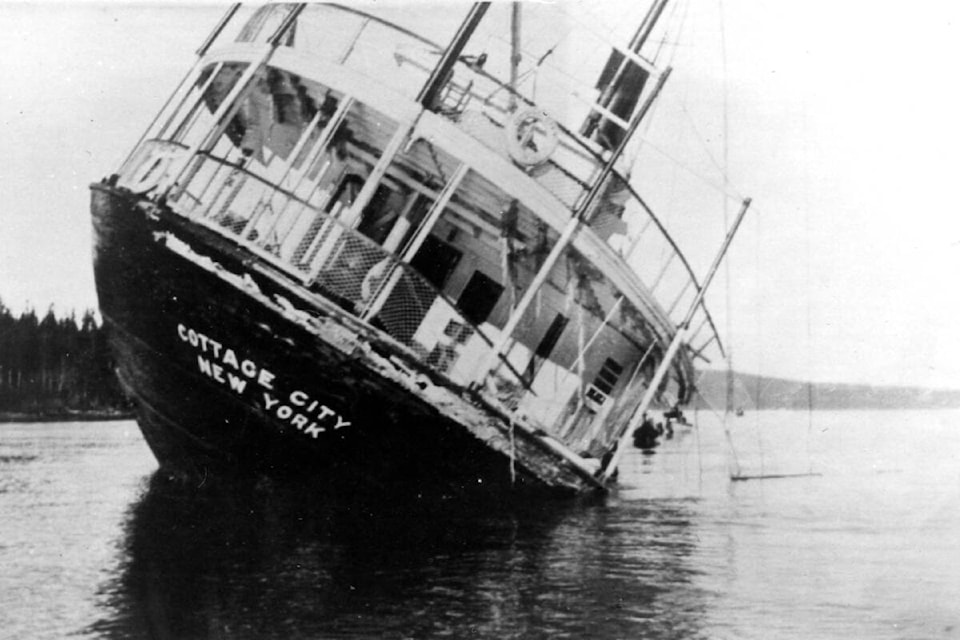You never know what artifacts might be found along the shores of the Discovery Passage and the stories that go along with them.
It was over 100 years ago on Jan. 26, 1911 at approximately 3:10 in the afternoon when a blinding snowstorm, treacherous current and heavy fog caused the steamship Cottage City to be shipwrecked about 200 yards offshore on the Willow Point Reef.
The 232-foot-long wooden-hulled steamer was first launched in 1890 and served the Maine Steamship Line for seven years, carrying passengers along the U.S. east coast. After that it was sold to the Pacific Coast Steamship Co. for service between Seattle and Alaska, carrying cargo and people eager to strike it rich in the gold rush in Alaska.
On the ill-fated voyage, she left Seattle for Alaska at 10:35 p.m. on a Wednesday night with 100 tons of freight, 59 crew, and 37 passengers, including six members of a vaudeville troupe bringing costumes, musical instruments, and equipment to entertain the legions of people eager to find their fortunes.
Captain Jensen knew the entrance to Discovery Passage was treacherous with the reef off Cape Mudge to the right and Shelter Point reef on the left. In the whiteout conditions of the snowstorm, it was impossible for Captain Jensen to make out landmarks to get his bearings. Sailing blind, he had no choice but to proceed into the Discovery Passage. But before he knew it, the Cottage City heaved and shook to a stop as she ran aground on the Willow Point reef and at 3:27 p.m., a radio distress call went out and reported all hands were abandoning ship.
Just as the life rafts were launching, the snowstorm began to lift. The first raft with 14 women and a four-year-old child followed the beacon of the Cape Mudge lighthouse and landed on the shores of Quadra Island. The lighthouse keeper at the time, a Scotsman named John Davidson, had done everything he could pumping his hand foghorn during the snowstorm, but the storm had altered the echo to make it difficult to gauge its position.
He guided the life raft to the beach with a white flag and offered a hot meal and lodging to the passengers. The other life rafts followed the shore and continued up to Campbell River with the ship’s papers and money. All the passengers and crew survived.
Most of the baggage on board was left behind, and Captain Jensen and officers remained with the ship to guard against looting and to meet any help that may arrive.
Early the next morning, the Snohomish arrived and picked up the passengers and crew and returned them to Seattle. The Salvor, a salvage steamer, arrived the same day to remove freight and bring it back to Seattle. According to local lore, not all the baggage was salvaged. It is said that many of the costumes from the theatre troupe ended up washing up on the beaches, and local loggers and townswomen partied in the streets wearing the vaudeville finery.
Plans were made to salvage the Cottage City, however, a more severe storm hit the coast on Feb. 3, making salvage efforts impossible and tore apart much of the ship. For the weeks that followed, heavy winds battered the exposed ship.
On Feb. 9, a radio message reported that masses of floating wreckage believed to be from the Cottage City were being carried away by the tide and found as far north as Chatham Point, 40 km away. Captain Jensen and his officers finally abandoned her, and the remains were sold for scrap. She was written off as a complete loss at a book value of $115,000 as listed in the Railway and Marine News of 1911.
In 1967, two divers by the names of Fred Rogers and Ed Seaton set out to find what was left of the Cottage City wreckage. They were successful in finding the exact location and a small collection of artifacts such as ornamental brass door handles, hinges, portholes, and lamp holders. The boilers, propeller and the main steam engines were nowhere to be found suggesting they had been hauled away in the salvage efforts.
